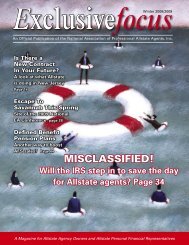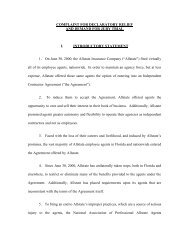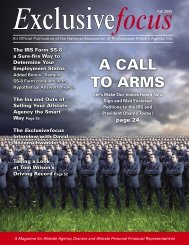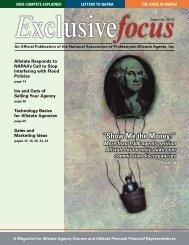Remembering Dick and Myra Larkin - National Association of ...
Remembering Dick and Myra Larkin - National Association of ...
Remembering Dick and Myra Larkin - National Association of ...
- No tags were found...
You also want an ePaper? Increase the reach of your titles
YUMPU automatically turns print PDFs into web optimized ePapers that Google loves.
They are assumptive comm<strong>and</strong>s intendedto have an impact on our behavior. Theyare unabashed employee controls.There is no doubt, that in making thestipulations contained in Sheely’s letter,Allstate is imposing behavioral controlover its agents. This new requirement toconform to a m<strong>and</strong>atory set <strong>of</strong> st<strong>and</strong>ardsimposed by the company is the clearestform <strong>of</strong> control Allstate has exerted todate. Because “behavioral control” is akey element used by the IRS to determinewhether a worker is an employeeor independent contractor, a higher st<strong>and</strong>ard<strong>of</strong> vigilance by the employer mustbe used. Allstate’s newest m<strong>and</strong>ate is ablatant violation <strong>of</strong> that precept.Training? We Don’t Need NoStinking Training!IRS Publication 15-A has been updatedfor 2009, but essentially contains thekey elements previously used to describethe employer/employee relationship. Onpage 6 <strong>of</strong> the publication, in the righth<strong>and</strong> column, is a section titled “Trainingthat the business gives the worker.” Itstates: “An employee may be trained toperform services in a particular manner.Independent contractors ordinarily usetheir own methods.”Employers are generally cautious to afault regarding m<strong>and</strong>atory training. Butwhether from mounting pressure causedby market conditions or from internalcorporate directives, Allstate has beensystematically violating IRS rules regardingsuch things as m<strong>and</strong>atory <strong>of</strong>ficehours, quotas, annual reviews, call forwarding<strong>and</strong> much more. Now Allstatehas fractured the “no m<strong>and</strong>atory training”element as well.Training is defined as the process<strong>of</strong> teaching or learning a skill. Trainingcan be used to improve a previouslylearned skill or to define parameters forthe performance <strong>of</strong> a particular job orduty. In all cases, the one being trainedis required to conform to a skill set beingsupplied by the trainer. Imposing newtraining requirements or changing an already-in-placeskill is a form <strong>of</strong> control.This is a significant element <strong>of</strong> control anemployer gives up when they utilize anindependent contractor. But, the trade<strong>of</strong>fis extremely beneficial tax treatmentfrom the IRS. It is only when companiesrenege on their promise <strong>of</strong> compliancethat both the worker <strong>and</strong> the IRS beginto take notice.Interestingly, had Allstate not producedits latest corporate memo, the trueextent <strong>of</strong> its training scheme might neverhave been brought to light. In its zeal toimplement new “accountability” st<strong>and</strong>ards,Allstate recounted the inclusion<strong>of</strong> a program designed to move forwardits latest corporate agenda. The name <strong>of</strong>the program is “Customer Service Expectations.”Likely, many <strong>of</strong> you reading thiswill not recognize the name. That’s becausethe element most <strong>of</strong> us are familiarwith is called “First Impressions.” In typicalAllstate fashion, a new program willhave been in place <strong>and</strong> implemented foryears before the agency force even hearsabout it or notices it.“First Impressions” is a m<strong>and</strong>atorytraining program, which was implementedin 2008 as a series <strong>of</strong> phonecalls to all agents. It is m<strong>and</strong>atory becausethe process <strong>of</strong> answering thephone automatically enjoins the agentin the training program. The purpose <strong>of</strong>the “First Impressions” program was/is toinstitute an Allstate-designed programwhich included a defined work process<strong>and</strong> the sequence in which the agentshould perform the work. But the programwas, <strong>of</strong> course, never touted as atraining program. It was introduced toagents as a way for them to improve“telephone skills.”The following are direct quotes fromthe program’s FAQ’s sent to each agent.“What: Series <strong>of</strong> 3 brief calls eachmonth to all agents through 2008 – conducted<strong>and</strong> scored by a vendor called InTouch assessing how agencies h<strong>and</strong>legreetings, closings, <strong>and</strong> voice tone.Why: Improve first impressions whencustomers call agencies – drive improvement<strong>and</strong> consistency into agency telephoneinteractions.When: Launched 4/1/2008 – ongoingthrough 2008”The reality <strong>of</strong> the “First Impressions”program was that it was intended to bea key element <strong>of</strong> the “Customer ServiceExpectations” m<strong>and</strong>ate. It is this m<strong>and</strong>atethat is central to Allstate’s control<strong>of</strong> the agents’ work product: interactionwith the customer. Allstate wasn’t evencoy when it unabashedly answered the“Why” behind the calls. It stated openlythat the program was designed to “driveimprovement <strong>and</strong> consistency intoagency telephone interactions.” Mostagents were at a loss as to how to rejectthis forced, m<strong>and</strong>atory training. As withother employee controls, agents remainunable to defend themselves without potentiallyimpacting their careers.To Allstate’s credit, they invented away to require m<strong>and</strong>atory attendanceat training classes without the agents’ability to reject the process. Agents areso used to using their computers to signon to remote training classes, or to callin to Citrix-based teleconferences forvoluntary training, that they overlookedthe sheer simplicity <strong>of</strong> what occurs whenthey answer the phone to take what theyhope is a customer calling for a quote.From Allstate’s perspective, theyknow that an agent “must” answer thephone. Therefore the agent is automaticallyrelegated to “m<strong>and</strong>atory attendance”<strong>of</strong> whatever happens next. The agent answersthe phone hoping it is a prospectiveor current client. The “trainer” whois on the other end <strong>of</strong> the line, then asksa question or series <strong>of</strong> questions <strong>and</strong> recordsthe agent’s response. The agentis then “graded” on his efforts <strong>and</strong> anevaluation is posted online for him to review.Agents are provided sample scripts,the sequence <strong>of</strong> questions <strong>and</strong> possibleresponses. Those who initially scoredpoorly are encouraged to adhere moreclosely to the script in order to attain ahigher score.This is classic “M<strong>and</strong>atory Training101.” Allstate wishes to modify what itsees as undesirable behavior. It ramps upa countrywide staff <strong>and</strong> evaluation system.Allstate implements calls to agent<strong>of</strong>fices knowing they must answer thephone <strong>and</strong> “attend” the training. Allstatecollects the data. Allstate delineates“good” behavior from “bad” behavior.Agents are contacted by managers to“help” them by reviewing their recordedcalls. Allstate provides agents withscripts <strong>and</strong> a sequence to follow. Allstateachieves modified behavior. AllstateSummer 2009 Exclusivefocus — 49
















